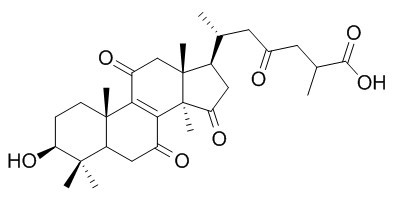Ganoderic acid AM1
Ganoderic acid AM1 treatment for 48 h inhibited the proliferation of HeLa human cervical carcinoma cells with IC(50) values of 19.8+/-0.7 microM.
Inquire / Order:
manager@chemfaces.com
Technical Inquiries:
service@chemfaces.com
Tel:
+86-27-84237783
Fax:
+86-27-84254680
Address:
1 Building, No. 83, CheCheng Rd., Wuhan Economic and Technological Development Zone, Wuhan, Hubei 430056, PRC
Providing storage is as stated on the product vial and the vial is kept tightly sealed, the product can be stored for up to
24 months(2-8C).
Wherever possible, you should prepare and use solutions on the same day. However, if you need to make up stock solutions in advance, we recommend that you store the solution as aliquots in tightly sealed vials at -20C. Generally, these will be useable for up to two weeks. Before use, and prior to opening the vial we recommend that you allow your product to equilibrate to room temperature for at least 1 hour.
Need more advice on solubility, usage and handling? Please email to: service@chemfaces.com
The packaging of the product may have turned upside down during transportation, resulting in the natural compounds adhering to the neck or cap of the vial. take the vial out of its packaging and gently shake to let the compounds fall to the bottom of the vial. for liquid products, centrifuge at 200-500 RPM to gather the liquid at the bottom of the vial. try to avoid loss or contamination during handling.
Biochem Biophys Rep.2024, 40:101830.
J-STAGE2015, 249-255
Exp Mol Med.2020, 52(4):629-642.
Molecules.2019, 24(16):E2985
J Pharmaceut Biomed2020, 182:113110
Preprints2021, doi:10.20944
Inflammation.2024, 02034-1.
Food Chem.2020, 327:126992.
Front Immunol.2017, 8:1542
The Thai Journal of Pharmaceutical Sciences2023, 47(3):3.
Related and Featured Products
Fitoterapia. 2014 Oct;98:254-9.
Triterpenoids of Ganoderma theaecolum and their hepatoprotective activities.[Pubmed:
25111010]
METHODS AND RESULTS:
Five new lanostane triterpenoids, ganoderic acid XL1 (1), ganoderic acid XL2 (2), 20-hydroxy-Ganoderic acid AM1 (3), ganoderenic acid AM1 (4) and ganoderesin C (5), together with five known triterpenoids (6-10) were isolated from the fruiting bodies of Ganoderma theaecolum. Chemical structures were elucidated on the basis of spectroscopic evidence, including 1D, 2D NMR, mass spectrometric data and circular dichroism spectra.
CONCLUSIONS:
Compounds 1, 4, 5, 8, 9 and 10 (10 μM) exhibited hepatoprotective activities against DL-galactosamine-induced cell damage in HL-7702 cells.
Phytomedicine. 2010 Jul;17(8-9):606-13.
Effects of triterpenes from Ganoderma lucidum on protein expression profile of HeLa cells.[Pubmed:
20092987]
To elucidate the cytotoxicity mechanism of Ganoderma triterpenes, a chemoproteomic study using five purified ganoderic acids, ganoderic acid F (GAF), ganoderic acid K (GAK), ganoderic B (GAB), ganoderic acid D (GAD) and Ganoderic acid AM1 (GAAM1) was conducted.
METHODS AND RESULTS:
GAF, GAK, GAB, GAD and Ganoderic acid AM1 treatment for 48 h inhibited the proliferation of HeLa human cervical carcinoma cells with IC(50) values of 19.5+/-0.6 microM, 15.1+/-0.5 microM, 20.3+/-0.4 microM, 17.3+/-0.3 microM, 19.8+/-0.7 microM, respectively. The protein expression profiles of HeLa cells treated with each ganoderic acid at dose of 15 microM for 48 h were checked using two-dimensional electrophoresis (2-DE). The possible target-related proteins of ganoderic acids, i.e. proteins with same change tendency in all five ganoderic acids-treated groups compared with control, were identified using MALDI-TOF MS/MS. Twelve proteins including human interleukin-17E, eukaryotic translation initiation factor 5A (eIF5A), peroxiredoxin 2, ubiquilin 2, Cu/Zn-superoxide dismutase, 14-3-3 beta/alpha, TPM4-ALK fusion oncoprotein type 2, PP2A subunit A PR65-alpha isoform, nucleobindin-1, heterogeneous nuclear ribonucleoprotein K, reticulocalbin 1 and chain A of DJ-1 protein were identified.
CONCLUSIONS:
Ganoderic acids might exert their cytotoxicity by altering proteins involved in cell proliferation and/or cell death, carcinogenosis, oxidative stress, calcium signaling and ER stress.



